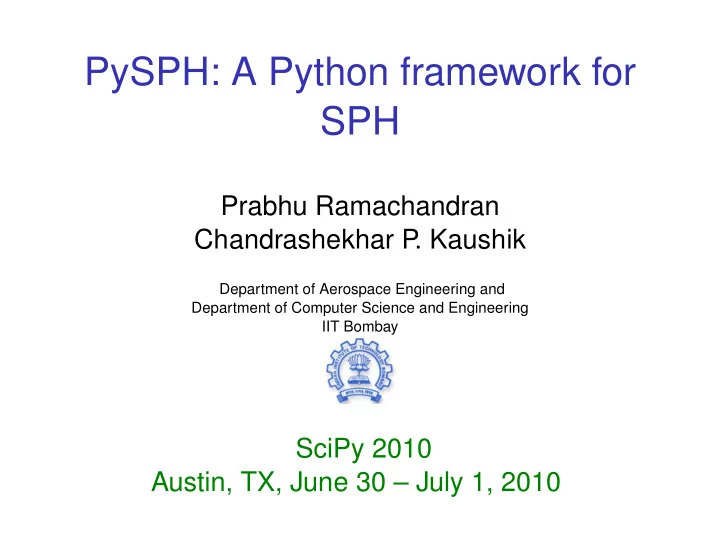

PySPH: A Python framework for SPH Prabhu Ramachandran Chandrashekhar P . Kaushik Department of Aerospace Engineering and Department of Computer Science and Engineering IIT Bombay SciPy 2010 Austin, TX, June 30 – July 1, 2010
Outline Introduction PySPH Architecture
Outline Introduction PySPH Architecture
SPH examples
SPH examples
3D
Parallel?
Smoothed Particle Hydrodynamics ◮ Particle based, Lagrangian ◮ Gingold and Monaghan (1977), Lucy (1977) ◮ PDEs ◮ Complex problems ◮ Moving geometries ◮ Free surface problems ◮ . . .
Smoothed Particle Hydrodynamics ◮ Particle based, Lagrangian ◮ Gingold and Monaghan (1977), Lucy (1977) ◮ PDEs ◮ Complex problems ◮ Moving geometries ◮ Free surface problems ◮ . . .
SPH basics ◮ The SPH approximation � f ( r ′ ) W ( r − r ′ , h ) dr ′ f ( r ) = ◮ W ( r − r ′ , h ) : kernel, compact support ◮ h : size of the kernel
SPH basics
SPH basics Nearest neighbors kh
SPH basics . . . ◮ Derivatives: transferred to the kernel ◮ Lagrangian ◮ PDE → ODE
Scale-up for larger problems requires parallelization
Motivation Reproducible and open research
Outline Introduction PySPH Architecture
PySPH ◮ SPH + Parallel + Python ◮ pysph.googlecode.com ◮ Open Source (BSD)
Requirements and installation ◮ Python, setuptools ◮ numpy, Cython-0.12, mpi4py-1.2 ◮ Mayavi-3.x (optional) ◮ Standard Python package install
High-level solver outline
Serial Dam break solver = FSFSolver ( time_step =0.0001 , total_simulation_time =10. , kernel=CubicSpline2D ( ) ) # create the two e n t i t i e s . dam_wall = Solid (name= ’ dam_wall ’ ) dam_fluid = Fluid (name= ’ dam_fluid ’ ) # The p a r t i c l e s f o r the wall . rg = RectangleGenerator ( . . . ) dam_wall . add_particles ( rg . g e t _ p a r t i c l e s ( ) ) solver . add_entity ( dam_wall )
Serial Dam break . . . # P a r t i c l e s f o r the l e f t column of f l u i d . rg = RectangleGenerator ( . . . ) dam_fluid . add_particles ( rg . g e t _ p a r t i c l e s ( solver . add_entity ( dam_fluid ) # s t a r t the solver . solver . solve ( )
Parallel Dam break solver = ParallelFSFSolver ( time_step =0.0001 , total_simulation_time =10. , kernel=CubicSpline2D ( ) ) # Load p a r t i c l e s in proc with rank 0.
Outline Introduction PySPH Architecture
Software architecture ◮ Particle kernel ◮ SPH kernel ◮ Solver framework ◮ Serial and Parallel solvers
Software architecture Solvers Solver Framework SPH (Cython) (Python & Cython) NNPS (Cython) Cell Manager (Cython) Particle Arrays (Cython) C−Arrays (Cython)
Particle kernel ◮ C-arrays: numpy-like but faster and resizable ◮ ParticleArray: arrays of properties ◮ NNPS (Nearest Neighbor Particle Search) ◮ Cell, CellManager ◮ Caching
SPH kernel ◮ SPH particle interaction: interaction between 2 SPH particles ◮ SPH summation: interaction of all particles
Solver framework ◮ Entities (made of particles) ◮ Solver components (do various things) ◮ Component manager (checks property requirements) ◮ Integrator ◮ Basic Solver
Parallel solver ◮ Parallel cell manager ◮ Parallel solver components
Parallel solver Serial case Solver components CellManager Particles Parallel case Processor 1 Processor 2 Solver components Solver components ParallelCellManager ParallelCellManager Particles Particles
Challenges ◮ Particles move all over ◮ Fixed partitioning will not work ◮ Scale up ◮ Automatic load balancing?
Terminology: Cell Cells Particles
Terminology: Region P1 P2 Region 2 Region 1
Terminology: Domain decomposition P3 (1,1,0) (2,0,0) O (−1,−1,0) (1,−1,0) P2 P1 P4
Approach ◮ Domain decomposition: Cells ◮ Cells: dynamically created/destroyed ◮ Processors manage Regions ◮ Cells moved to balance load
Load Balancing Donate Cells ◮ Boundary cells ◮ Cells with least number of local neighbors
Load balancing
Efficiency
Efficiency
Current capabilities ◮ Fully automatic, load balanced, parallel framework ◮ Relatively easy to script ◮ Good performance ◮ Relatively easy to extend ◮ Free surface flows
Immediate improvements ◮ Solver framework redesign ◮ More documentation ◮ Reduce dependency on TVTK for easier installation ◮ Improved testing on various platforms ◮ Gas dynamics (coming soon) ◮ Solid mechanics (next year)
Thank you!
Recommend
More recommend